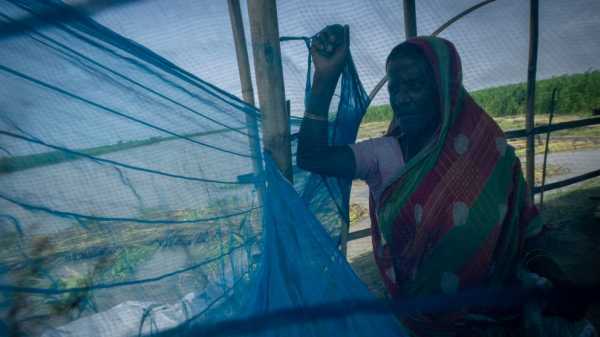
MORIGAON, India — Monuwara Begum is growing weary of moving every time water pours into her home.
The 45-year-old farmer, who lives on an island in the mighty Brahmaputra River in the northeastern state of Assam, said she and her family suffer from more violent and erratic floods each year.
They live in knee-deep water inside their small hut, sometimes for days. Cooking, eating and sleeping, even as the river water rises.
Then when the water engulfs their home completely, “we leave everything and try to find some higher ground or shift to the nearest relief camp,” Begum said.
Begum is one of an estimated 240,000 people in the Morigaon district of the state that are dependent on fishing and selling produce like rice, jute and vegetables from their small farms on floating river islands, known locally as Chars.
When it floods, residents of Char islands often row in makeshift rafts with a few belongings, and sometimes livestock, to dry land. They set up temporary homes with mosquito nets.
Having nowhere else to permanently go, they then go back when the water subsides, clean up their homes and resume farming and fishing to make ends meet.
Begum said the river has always intruded on the Chars but it has become much more frequent in recent years.
“We are very poor people. We need the government’s help to survive here since this is our only home. We have nowhere else to go,” she said.
The Assam state government has devised a climate action plan which has guidance on dealing with weather events but the Indian federal government has yet to approve the plan. The state also does not have a separate budget to implement the plan.
Increased rainfall in the region due to climate change has made the Brahmaputra River — already known for its powerful, unpredictable flow — even more dangerous to live near or on one of the more than 2,000 island villages in the middle of it.
India, and Assam state in particular, is seen as one of the world's most vulnerable regions to climate change because of more intense rain and floods, according to a 2021 report by the Council on Energy, Environment and Water, a New Delhi-based climate think tank.
Begum and her family, and other Char island dwellers, are on the frontline of this climate-induced fury, year after year.
___
AP climate and environmental coverage receives support from several private foundations. See more about AP’s climate initiative here. The AP is solely responsible for all content.
Sourse: abcnews.go.com






